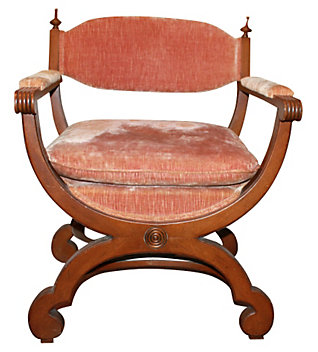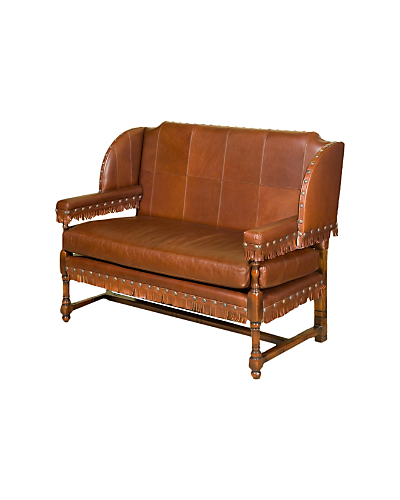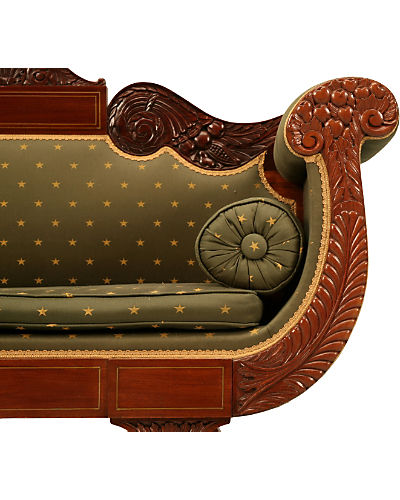 Upholstery is about comfort and style something humans have been remiss to live without since the time of ancient Egyptians, who used horsehair-stuffed cushions and fine fabrics draped across their daybeds and gilded thrones. It’s hard to imagine a living or family room without your favorite
Upholstery is about comfort and style something humans have been remiss to live without since the time of ancient Egyptians, who used horsehair-stuffed cushions and fine fabrics draped across their daybeds and gilded thrones. It’s hard to imagine a living or family room without your favorite
comfy sofa or cushy chair, but upholstery hasn’t always been around. We will introduce you to the history of upholstery. Curl up in your
comfiest, most relaxing piece of upholstery and we will take you on a
historical tour.
The Evolution of Upholstery in Home Decor: From Tapestries to Tufts
What is now a thriving industry, and the single-most effective way to change the look and feel of an entire room, upholstery has a long and interesting history of evolving along with the home, its inhabitants, and the increasingly complicated techniques of furniture makers.
Despite weavers fine-tuning their craft for centuries, the earliest attempts at real upholstery were little more than fabric stretched across a seat—proof that the two industries had yet to be in lockstep with one another. From hard oak seats to the tufted comfort of Victorian sofas, here’s a look at the history of upholstery.
Medieval Upholstery: Dorcers, Drapery & Tapestries

The most comfortable that a Medieval chair was going to get was the slung leather of a coffer-maker’s chair. This version demonstrates the later treatment of upholstery and cushions.
Textiles have been around as long as furniture—even longer. But not always in as perfect a union as they are today. Like any specialized industry, upholstery got its roots early with the upper classes, skills spread throughout Europe’s tradesmen, and technology and mechanization allowed it to bloom. In the 1500s, Italy established itself as a hub for fine textiles. Sumptuous velvet came from Genoa, and expensive silk from Lucca, surpassing anything else made worldwide.
The skills in Italy spread to Britain, and by 1560, weavers were busy making wall hangings, drapes for beds, and various cushions. Overall, what very early furniture and the homes they filled lacked in comfort, people could make up for with yards upholstery: cushions on hard, boarded oak chairs, with needlework done by the lady of the house; bankers, the drapery over the seat and footboard of bench-like settles; and dorcers, which hung on the stone walls that people leaned against while sitting on benches. Upholstered seats were rare until about the 17th century; even then, they were reserved for the wealthy.
The finest tapestries during Medieval times were those made by Flemish weavers, who were becoming renowned throughout Europe for their trade, a reputation that would continue to spread into the 17th century.
Tudor Gothic England: Elizabethan Domestic Comfort & the Rise of the Upholsterer

A back stool, also known as an “upholsterer’s chair.”
As standards of living were not-so-slowly on the rise, so were people’s expectations for comfort. With the end of the War of the Roses, men weren’t completely preoccupied with fortifying their homes—kind of a big deal when you imagine they lived in fear of their houses being burned down day to day, so weren’t considering putting money into how nicely furnished they were. With the money, space, and time to finally think about upgrading, a new industry flourished.
The first order of business? Using upholstery to manage drafty rooms.
In the Elizabethan era, sleeping arrangements in the home vastly improved. Enormous “bedsteads” were created—one with wood paneled head and footboards (much like beds today), and one with four posters, both of which evolved into enormous, carved structures draped entirely on all sides with heavy curtains to protect from drafts. The result was like an upholstered room within a room—a cozy luxury in a time when lesser members of households were sleeping communally on rush mats.
Chests were still the most important piece of furniture, but as people kept making adjustments for more and better comfort, settles developed. As the bottom, chest-like portion was eliminated for more complicated legs and stretchers, fabric was used decoratively to drape down over the front—most likely for decorative purposes, but also for blocking feet from drafts.
It was where chairs were concerned that upholsterers firmly ensconced themselves in furniture-making, becoming a legitimate (although, still expensive) industry. An Elizabethan development, the Farthingale chair (or back stool), was created without arms to accommodate large skirts, and its small, square back and seat were covered with leather stretched across it, trimmed in nailheads—permanent upholstery, for the first time!—rather than outfitted with a loose cushion. Upholsterers became more involved in creating chairs with permanent coverings, although simple, loose “squab” cushions were still predominant. The back stool came to be known as “an upholsterers’ chair,”—but comfort as we know it today was still a long way’s off.
Elizabethan coverings included: leather, brocade or colored cloth embroidered with silk, and velvet trimmed in heavy fringe.
Jacobean Furniture: Upholstery’s Beginnings

An upholstered Jacobean chair.

The first fully upholstered sofa, The Knole Settee.
In the 17th century, carpets were heavily imported from Turkey to Europe, but for the most part, European craftsmen were handling them without much care, cutting rugs up for use as seat cushions. It became popular to imitate Turkish carpets, a practice of drawing strands of wool through a linen backing, which came to be called “turkey work.”The most popular upholstery option, turkey-work was colorful, brightly patterned, and more or less a synonym for Baroque style.
But upholstery still was not a part of the general repertoire, and this has a lot to do with the overall attitude of the times. Upholstered chairs seem obvious today, but back then the connotation took awhile to catch on. “In early days the chair was a seat of honour; there would probably be only one in even a large hall, and a man using it would not look specifically to find comfort in it.”1 But a hesitancy toward upholstery goes even further than that. “Anything in the way of comfort was regarded with a certain feeling of contempt and was felt to be effeminate. Shakespeare, in his Richard III, makes Buckingham say, “This prince in not an Edward! He is not lolling on a lewd day-bed.”2 But James I was a bit more effeminate himself, and men in general dropped their “Spartan-like outlook”—and the upholstered chair got its footing.
Jacobean furniture itself stayed in the same vein as Elizabethan, with a few adjustments along the way. Things were still made from oak, and were still blocky in nature due to those making it: carpenters with carpenter’s tools, and carpenter’s skills. But the first stuffed seats are seen on revival-style, X-frame chairs (pictured). In England, the “Upholder’s Guild” was the basis for the name “upholsterer,” a booming industry that brought about the coffer-maker’s chair, luxurious bed hangings, and cushions filled with down, feather and hair.
Renaissance Spain: Moorish Influence

Tooled leather typical of Renaissance-era Spanish chairs.
Leather was pretty well established as a common chair covering, but the tooled leather upholstery in Spain during the Renaissance was the most magnificent. Also in Renaissance Spain, gorgeous colorful tapestries and other exotic materials covered fraileros, simple chairs that were known for their multitude of coverings, as well as Turkish divans—low sofas completely covered in stuffed cushions—that were carry-overs from the Moors’ Middle Eastern roots. The biggest piece of the puzzle, however, is in beautiful, taut decorative leather covering and the dark wood frames—a moody combination that would come to always impart an exotic, Mediterranean feel.
The Walnut Period: Refining Comfort & The Rise of Textile Factories in Europe

A tapestry-covered Louis XIII-style settee.

A needlepoint-covered French settee in the late Rococo style.

Needlepointed upholstery and fringed trim wrap around the frame of a Baroque-style armchair.

Example of a loose cushion on a wooden chair, still used for extra comfort on caned seats.
The Walnut Period itself was a big deal for design in England: King Charles’ foreign tastes shook things up, followed by King William’s being an actual foreigner. England welcoming the Protestant refugees in the 1660s meant that the renowned Flemish weavers known for their magnificent tapestries were settling in Britain, helping to establish the famous Mortlake Tapestry Factory in London as one of the finest in Europe. In France, underLouis XIV, the Gobelins Factory was created just outside of Paris, making spectacular tapestries and fabrics for use in upholstery, as well as furniture that lined the halls of the royal palaces. Naturally, when the Huguenots were forced to flee France, finding protection in England and the Netherlands, the textile and upholstery industries in these countries flourished, with the help of these talented refugees.
With Charles II on the throne, the Puritan regime ended, and the decorative arts flourished again in England. People were back to seeking comfort, and yearning for furniture for every occasion. Whereas chests once served a ton of different purposes, there were now tables for everything, china cabinets, buffets, cupboards, daybeds, and chairs specifically for relaxation. In 1705, during Charles II’s reign, we see the first fully upholstered armchair. Caned seats (and, less expensive, rush seats) completely dominated the scene, adding extra comfort and give to seats and chair backs that wood could not provide. The popularity of the daybed was redefining relaxation, offering a clearer distinction between the bedroom and the living room. And custom cushions accompanied almost everything.
Upholstery finally took over as the most popular treatment during William’s transitional style of furniture: William & Mary-style high-backed chairs were upholstered, and the winged easy chairs (and “sleeping chayres”) also boasted all-over upholstery.
Chairs began to more closely resemble what we know today. The Huguenot craftsmen in England made Queen Mary gorgeous silk for ornate upholstery. During the Queen Anne period, upholstery was used much more often: silk damask, wool moreen, often including elaborate embroidery, needlework, crewelwork, and Turkey work. Cushions were horsehair, with linen lining, and down for suspension.
Beds were one of the most upholstered items in the house: William & Mary-style bedsteads and later, Queen Anne bedsteads, were totally covered in soft fabric, like velvet. The only catch to this cozy enclave? These coverings couldn’t just be taken off and washed; entire beds had to be stripped to the frame, then reupholstered.
Early American Luxury: Upholstery in the Colonies
The Pilgrims had a different set of challenges to contend with, but those who could afford to import fine fabrics stayed pretty well on track with the trends back in Europe: turkeywork, needlework, leather, or caned seating. The Cromwell settee, based off the general design of the Cromwellian chair, was itself a luxury in Colonial homes, and common ground for fine covering. More often than not, Colonial homes reverted back to basics, but where time and energy allowed, it was their own wives and children who contributed needlework to upholstery.
Mahogany Period Furniture: The Age of the Designer & the Drop-In Style Seat Cushion

A Victorian side chair with a drop-in cushioned seat.

A fully upholstered mahogany Chippendale-style daybed.

The soft palette of the Neoclassical era on an American Federal-style settee.

Regal upholstery on an Empire-style sofa, with round bolster pillows on either end.
During the Age of the Designer, upholstery was very much integrated into the furniture-making process, and, other than paint, was the primary way designers could implement the going styles. Choosing what colors and fabrics to use in-house set the trends and upholstered furniture dictated the color palettes of the era.
Comfort improved (and upholsterers became integral parts of the chair-making process) with the innovation of the drop-in seat. After being constructed, the chair’s seat is left open, fastenings and supports are built, and then the stuffed and upholstered seat is fixed inside the frame. Drop-in seats weren’t exclusive, however: the “stuff-over” method was also popular, with fabric covering the seat and the seat rail.
Architect and tastemaker Robert Adam’s Neoclassical chairs were clad in bright pastels, complementing his Palladian-style interiors—and so did Louis XVI’s chairs, in soft blues, pinks, and yellows. Thomas Chippendale’s camelback sofas were some of the first to be completely upholstered, except for exposed legs. Chinoiserie silks were used to complement his designs in “the Chinese taste,” some of his most iconic designs. Overall, upholstery was winning out over the elaborate carving of the Rococo period.
George Hepplewhite‘s book The Cabinet-maker and Upholsterer’s Guide, similarly, offered guidance in interior design, color palettes, and how to arrange a room. His seats were wonderfully overstuffed, finished with brass nailheads, and covered in delicately colored haircloths and silk. Overlapping with Hepplewhite’s style, with a few differences, Thomas Sheraton published the Cabinet Maker’s & Upholsterer’s Drawing Book (1791), and his chairs favored the same soft color palettes, and utilized horsehair stuffing.
The Neoclassical era was followed up by the Empire and Regency styles, bold revival styles that used rich jewel toned upholstery like velvet, perfect for offsetting the luxurious treatment of the frames: gilded, painted, or black lacquer. The iconic cornucopia-armed sofas of the period almost always featured matching, upholstered round cushions on either end.
Advancements of the 19th Century
Victorian Opulence: Perfecting the Steel Coil Spring

A tufted leather Chesterfield sofa.

All-over button tufting seen on a Belter laminated settee.
Modern upholstery would drop its associations with certain areas or groups of people, thanks to two major innovations that changed the upholstery industry immensely: the invention of thesteam-powered engine, which provided cheap power to machine looms for the mass-production of machine-woven fabrics, and the steel coil spring, which changed comfort forever. Upholstery also began to be more at the discretion of the buyer: with wide availability of fabrics and more individual shops opening up, there was more variation. Hepplewhite style, for example, was famously clad in soft, more delicate colors, and households followed suit. Modern upholstery was more for breaking the rules, and expressing personal style.
Inner springs inside seat cushions were revolutionary—the problem of stuffing shifting around or only lightly deflect the hard wood underneath was solved. Springs added an incredible lightness and resilience to seating. Add the heavy tufts and overstuffed look of sofas and settees to the spring coil construction, and you had furniture built for lounging.
An unusual hiccup in the progression of upholstery was the sideline Arts & Crafts style, a clean, simple approach to making furniture that caught on in America, and went hand-in-hand with the rustic Mission style. The philosophy was all about a return to a more “honest” way of doing things: carpentry, solid jointing techniques, sturdy oak, and minimal embellishment. Furniture-makers likeWilliam Morris and the Stickley Brothers favored medieval-style nailhead trimmed leather and Baroque tapestry.
But Victorian style was all about lush comfort, dubbed the Age of the Upholsterer: shiny silks and brocades, velvet, and leather all got the button-tufted treatment, not to be outdone by the incredible carving of their Rococo Revival frames, most notably by John Henry Belter. A simpler upholstery was also popular—cross-stitch embroidery on canvas or wool that women could make at home—but more often, fringes and tassels were used, without much reserve.
Modern Materials

Modern wool seat cover from Knoll Associates on a Harry Bertoia Diamond chair, 1952.
More futuristic materials weren’t far off, with streamlined styles like the Bauhausschool of design and the radiant metallics of Art Deco style. In 1935,nylon was invented at the DuPont research facility in Wilmington, DE. This silky fabric, used across a multitude of applications from toothbrushes to pantyhose, became a synthetic substitute for silk when World War II led to its scarcity. It proved to be durable, resilient, resistant to the elements that led to the wear and tear of traditional upholstery (like pests, rot, etc.), and was very affordable.
With new furniture shapes made possible by the use of bent steel, molded fiberglass, plywood and molded foam cores, upholstery was again revolutionized, taking on the textures and colors of a new era—one of sleek, modular, modern design. Famous design house Knoll Associates, which counted among its designers some of the most famous names in Mid-Century Modern design, created a number of iconic custom textiles that are still used today.
1. [Hayward, Charles H. English Period Furniture. 1959. Charles Scribner's Sons, New York, NY. pg 54.]↩


















